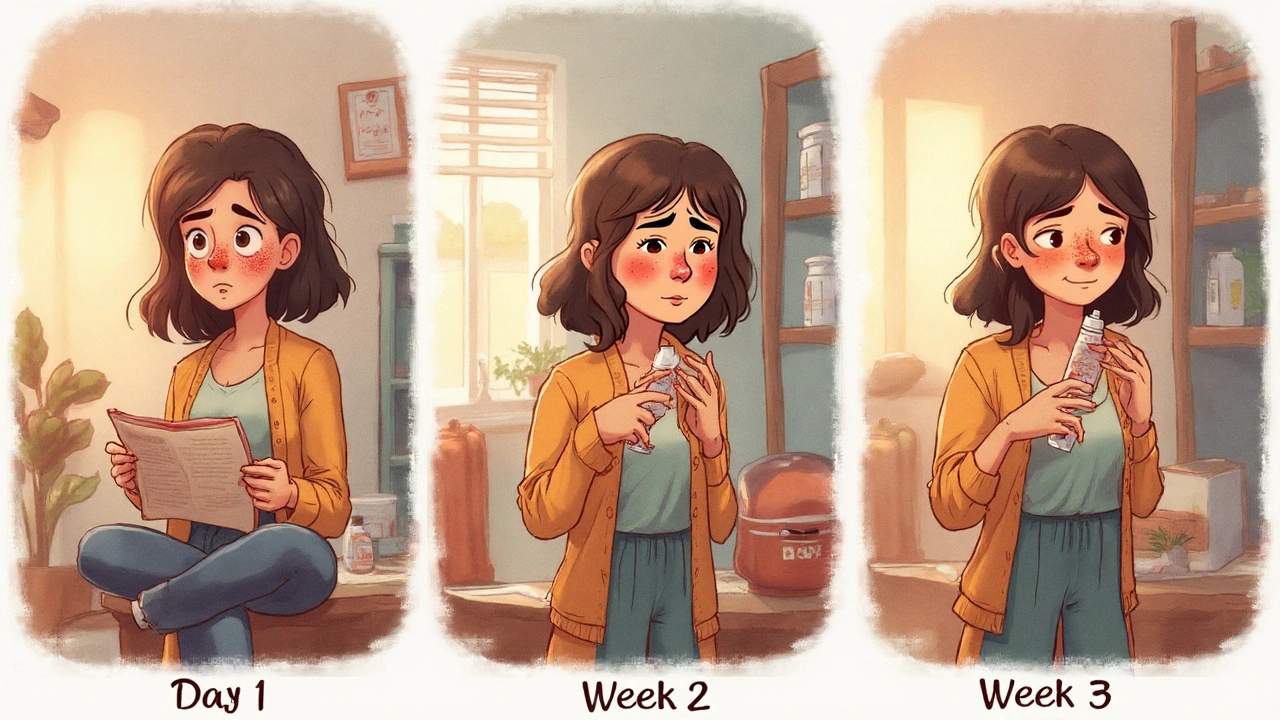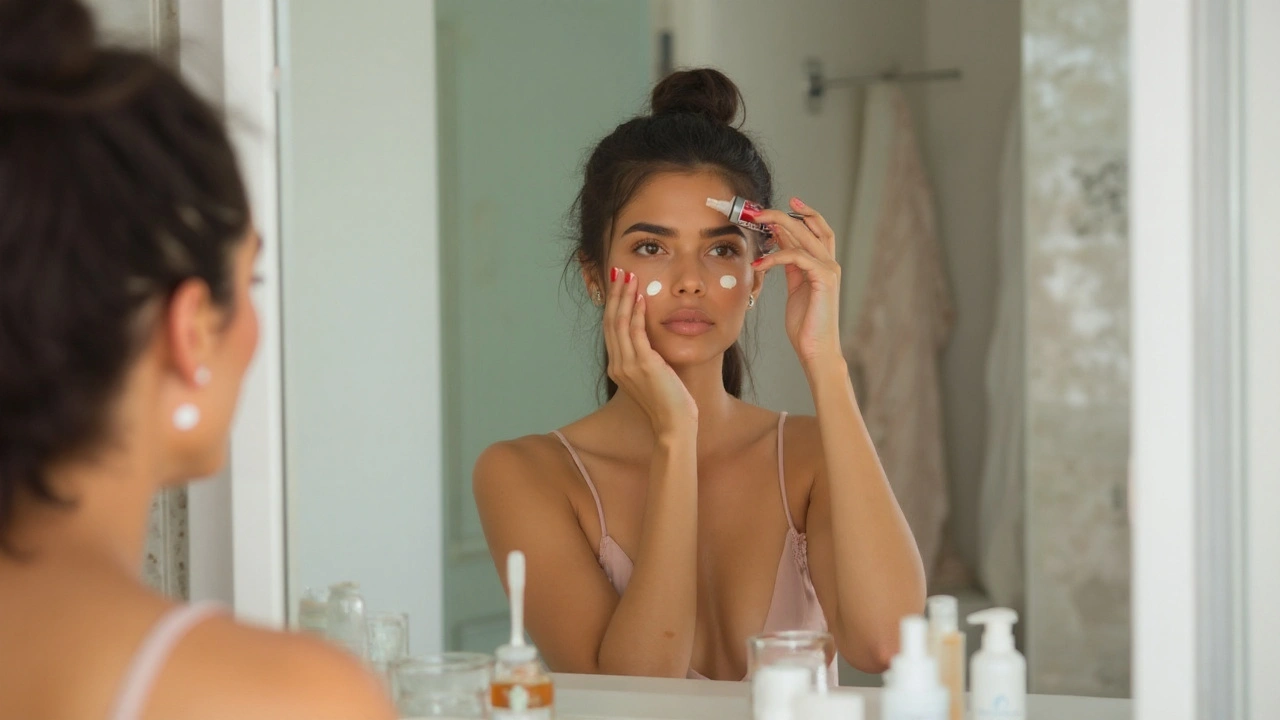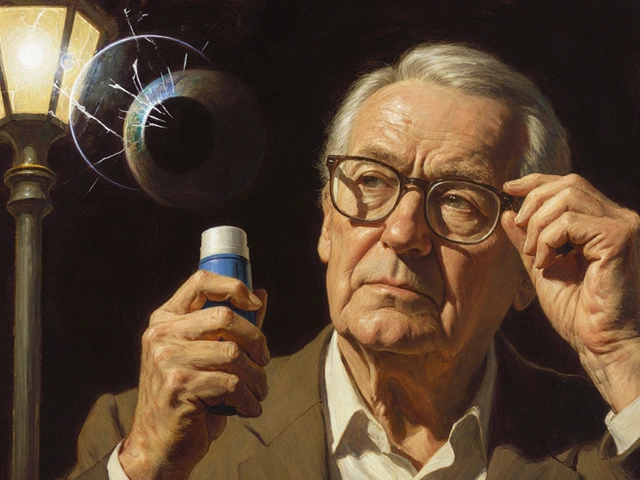TL;DR
- Azelaic acid lowers inflammation, trims excess keratin buildup, and nudges Malassezia yeast out of the spotlight-key drivers of seborrheic dermatitis.
- Use 10% nightly for sensitive starters; 15-20% is stronger and often prescribed for moderate facial flares. Expect calmer redness and less flaking in 2-4 weeks.
- Pair it with antifungal shampoos (ketoconazole, ciclopirox) for scalp; use it on hairline, brows, sides of nose, and beard area for the face.
- It’s generally well tolerated, pregnancy-safe, and melanin-friendly, with low risk of bleaching or steroid side effects.
- Not a solo hero for severe, crusty flares-combine with antifungals and short steroid bursts if your clinician advises.
Why azelaic acid helps seborrheic dermatitis
Red, itchy, flaky patches around the nose, brows, ears, chest, or scalp? That’s classic seborrheic dermatitis-an inflammatory response to skin yeast (Malassezia), plus a tendency for skin cells to pile up and stick. You get burning, shine, and that frustrating “I moisturised but still flake” look.
This is where azelaic acid earns its place. It targets three things that keep seborrheic dermatitis going:
- Inflammation: It calms pro‑inflammatory pathways (including reactive oxygen species). Less sting, less flush.
- Keratin go‑slow: It normalises how fast skin cells grow and shed. Flakes loosen faster and stick less.
- Microbe balance: While not a traditional antifungal, it shifts the local environment in a way that’s less friendly to Malassezia overgrowth.
What does the evidence say? European S3 guidelines (2015) include azelaic acid as a facial option for seborrheic dermatitis, especially when you want anti‑inflammatory help without steroids. DermNet NZ (reviewed 2024) lists azelaic acid 20% cream as helpful for facial seborrhoeic dermatitis. A Cochrane review (2015) backs antifungals as first‑line and notes adjuncts like azelaic acid can improve redness and scale, with benefit seen within weeks. Small randomised and open‑label trials have reported better erythema and scaling scores using 15-20% azelaic acid on the face, with lower relapse risk than vehicle after 4-8 weeks.
Why choose it over steroids? Topical steroids knock down flares fast but can thin skin and trigger perioral dermatitis if overused, especially around the nose and mouth. Azelaic acid offers steroid‑sparing control-you can use it long‑term on facial hotspots like the sides of the nose, brows, and hairline without those steroid risks.
Bonus perks: It can fade post‑inflammatory marks and help with clogged pores. If you also deal with acne, rosacea‑like flush, or that shiny T‑zone that peels anyway, azelaic acid checks multiple boxes with one tube.
Local to New Zealand? In 2025, you’ll find 10% azelaic acid serums OTC in pharmacies, and 20% creams (such as Skinoren equivalents) via prescription. Zinc pyrithione shampoos remain on shelves here, while EU changes don’t apply locally. Wellington’s cold wind and indoor heating can spike flares; azelaic acid holds up well in that stop‑start climate.

How to use it on face and scalp (simple routines that work)
Your goals here are simple: calm the flush, lift the scale, and stop the “flare-clear-flare” loop. Start slower than you think, pair it right, and give it a month before you judge.
Face routine (sides of nose, brows, hairline, ears, beard area)
- Cleanse: Use a gentle, low‑foam wash. Skip hot water.
- Pat dry fully: Damp skin spreads product faster and can sting more.
- Apply azelaic acid: Start pea‑size for the whole “T” and beard area. Frequency: every second night for 1 week, then nightly if calm. Strengths:
- 10%: good for sensitive skin or melanin‑rich complexions testing tolerance.
- 15-20%: for visible redness/scale that keeps bouncing back.
- Moisturise: Seal with a barrier cream or gel with ceramides/squalane. If you sting, moisturiser first, azelaic second for a week (buffering).
- AM: Sunscreen SPF 30+ daily. UV fuels inflammation, even in winter.
What to expect: Less sting by week 1, fewer flakes by week 2, visible redness down by weeks 3-4. Maintenance is low and steady-3-5 nights weekly once clear to prevent rebound.
Pro tips that save you time and skin:
- Patch test: Try a thin swipe behind the ear for two nights.
- Apply thin: More isn’t faster. A translucent film is perfect.
- Sting for 5-10 minutes is common early on; it should fade within a week. If it lingers, buffer with moisturiser or drop frequency.
- Avoid raw, cracked patches until they’re less open. Start around the edges, then move in.
- If you shave, apply azelaic acid at night on shave days to reduce sting.
Scalp and hairline plan
Think of azelaic acid as your facial anchor, and medicated shampoos as your scalp workhorse.
- Shampoo rotation (2-4 weeks to settle):
- 2-3x/week: ketoconazole 2% or ciclopirox 1% (leave on 3-5 minutes).
- Alternate: selenium sulfide 1% or zinc pyrithione 1%. Switch when results plateau.
- Hairline, brows, behind ears: After drying, dab a thin layer of azelaic acid nightly for 2-4 weeks, then 3 nights/week for upkeep.
- Heavy scale? Soften first: Massage a little mineral oil or a urea 10% cream for 30 minutes, then shampoo out. Apply azelaic acid after the area is dry.
When you might add other tools:
- Short steroid burst (e.g., hydrocortisone 1%): 3-5 nights for hot, angry patches-then stop. Keeps side effects in check.
- Non‑steroidal anti‑inflammatories (pimecrolimus 1% or tacrolimus 0.03%): Handy around the eyes and folds if you’re steroid‑averse.
- Climbazole or ketoconazole face wash 1-3x/week: A quick, soapy assist for stubborn T‑zones.
How it pairs with other actives
- Niacinamide: Great teammate for redness and barrier repair. Layer before or after-no drama.
- Salicylic acid: Helpful once or twice weekly for scaling, but go light to avoid over‑exfoliating.
- Vitamin C: Fine in the morning if your skin is calm. If you sting, split days.
- Retinoids: Possible, but alternate nights and moisturise more.
Safety, skin types, and special cases
- Sensitive skin: Start at 10% every second night. Buffer with moisturiser for the first week.
- Melanin‑rich skin: Low risk of lightening. It can actually help post‑inflammatory marks. Go slow to avoid irritation, which can trigger hyperpigmentation.
- Pregnancy and breastfeeding: Considered safe due to minimal absorption (AAD patient guidance; Medsafe data sheets). Skip on broken skin.
- Beard areas: Apply with the grain and very thinly. If you use beard oils, let them absorb first, then apply azelaic acid later.
- Athletes/sweaters: Sweat can sting. Apply at night, not right before training.

Choices, comparisons, FAQs, and troubleshooting
How does azelaic acid compare to other go‑tos?
| Option | Main role | Where it shines | Onset | Pros | Watch‑outs |
|---|---|---|---|---|---|
| Azelaic acid 10-20% | Anti‑inflammatory + keratin‑normalising | Face (sides of nose, brows, hairline), beard area | 2-4 weeks | Steroid‑sparing long‑term control; helps marks; acne/rosacea crossover | Mild sting early on; not a scalp soloist |
| Ketoconazole 2% (shampoo/cream) | Antifungal (Malassezia) | Scalp and face flares | 1-3 weeks | Strong first‑line for dandruff | Can dry hair/skin; rare irritation |
| Ciclopirox 1% | Broad antifungal + anti‑inflammatory | Stubborn scalp cases | 1-3 weeks | Good if ketoconazole stalls | Availability varies; cost |
| Selenium sulfide / Zinc pyrithione | Antifungal | Everyday dandruff control | 1-3 weeks | Affordable; easy rotation | Dryness; scent; EU restrictions don’t apply in NZ |
| Hydrocortisone 0.5-1% | Quick anti‑inflammatory | Short bursts for angry flares | Days | Fast comfort | Not for long‑term facial use |
| Pimecrolimus/Tacrolimus | Non‑steroidal anti‑inflammatory | Eyelids/folds; steroid‑sparing | 1-3 weeks | Good for sensitive zones | Price; warmth/tingle early on |
Quick checklists
Starter checklist (face):
- Pick strength: sensitive or first‑timers → 10%; persistent facial redness/flake → 15-20% (often prescription).
- Introduce slowly: every second night for a week, then nightly if calm.
- Moisturise generously; sunscreen every morning.
- Pair a medicated shampoo for scalp, even if your face is the main issue.
What not to do:
- Don’t pile on exfoliants (AHA/BHA) nightly with azelaic acid in week one.
- Don’t spot‑treat only the flakiest patch; sweep the whole affected zone to prevent “halo” flares.
- Don’t quit at day 7-most benefits show after week 3.
Evidence notes and credibility
What we know from reputable sources: European S3 Guideline (2015) lists azelaic acid as a facial option for seborrheic dermatitis when steroid‑sparing control is preferred. A Cochrane Review (2015) emphasises antifungals first, with adjuncts like azelaic acid improving symptoms versus vehicle in small studies. DermNet NZ (2024 update) includes azelaic acid 20% cream among helpful topicals for facial disease. AAD patient guidance notes azelaic acid’s anti‑inflammatory benefits and safety in pregnancy and breastfeeding. This lines up with real‑world dermatology practice in 2025, especially for recurrent facial flares.
Mini‑FAQ
Is azelaic acid enough on its own? Often for mild facial cases, yes. For scalp or angrier flares, combine with antifungal shampoos and, if needed, a short steroid burst prescribed by your clinician.
How long before I see results? Flakes usually ease in 1-2 weeks; redness takes 2-4. Keep going another 2 weeks once clear, then shift to maintenance.
Can I use it year‑round? Yes. That’s the point-steady, steroid‑sparing control. You can dial down to 3-5 nights weekly once controlled.
Will it lighten my natural skin tone? No. It can lighten post‑inflammatory marks by calming pigment triggers, but it doesn’t bleach normal skin.
What if it stings? Buffer with moisturiser, reduce frequency, or try 10%. If sting lasts beyond 10-15 minutes or you develop hives, stop and check in with a clinician.
Pregnant or breastfeeding? Generally considered safe due to minimal absorption, per AAD and Medsafe data sheets. Avoid on broken skin. When in doubt, confirm with your GP or midwife.
Can I use it around the eyes? Stay on the bony orbital rim only. For eyelids, ask about pimecrolimus/tacrolimus instead.
Beard dandruff? Yes, apply very thinly after cleansing at night. Keep oils light and non‑fragrant.
Next steps and simple decision paths
Pick the scenario that sounds like you:
- Mild face redness + flakes, no scalp issues: Start 10% azelaic acid every second night for 1 week, then nightly. Add sunscreen AM. Reassess at week 4.
- Moderate facial flares + some scalp dandruff: Ask your GP about a 15-20% cream for nightly use. Use ketoconazole or ciclopirox shampoo 2-3x/week. Consider a 3‑to‑5‑night hydrocortisone burst if it’s burning.
- Stubborn scalp with hairline flakes: Lead with medicated shampoos; add azelaic acid to hairline, brows, and behind ears nightly. Use oil or a urea cream to soften thick scale before washing.
- Very sensitive skin: Buffer with moisturiser, start 10% twice weekly, then step up slowly. Avoid stacking exfoliants for the first two weeks.
- Melanin‑rich skin with dark marks: Keep it gentle, consistent, and sun‑protected. Azelaic acid can help even tone while calming the dermatitis.
When to see a pro:
- No improvement after 4-6 weeks of good adherence.
- Oozing, honey‑crust, or tender swelling (possible secondary infection).
- Widespread rash beyond typical SD zones.
- Frequent relapses needing steroid bursts more than twice a season.
Quick Wellington‑tested routine you can copy tonight:
- Warm (not hot) shower; gentle face wash.
- Pat dry. If windy day sting is real, moisturiser first.
- Thin layer of azelaic acid across the nose folds, brows, and hairline.
- Moisturiser on top. Bed. In the morning, SPF 30+ and a hat if you’re walking the waterfront.
Final rule of thumb: treat the zone, not just the spot. Seborrheic dermatitis loves to travel the T‑zone highways. Keep azelaic acid thin, consistent, and teamed with antifungal shampoo for best odds of a quiet, flake‑free month.






Written by Martha Elena
I'm a pharmaceutical research writer focused on drug safety and pharmacology. I support formulary and pharmacovigilance teams with literature reviews and real‑world evidence analyses. In my off-hours, I write evidence-based articles on medication use, disease management, and dietary supplements. My goal is to turn complex research into clear, practical insights for everyday readers.
All posts: Martha Elena